
Topics
Guests
- Dr. Michio Kakua professor of theoretical physics at the City University of New York and the best-selling author of Hyperspace: A Scientific Odyssey Through Parallel Universes, Time Warps, and the 10th Dimension. Dr. Kaku is a Japanese American whose parents were interned in concentration camps during World War II. He was a protégé of Edward Teller, the main scientist behind the development of the H-bomb. But he has since become a leading scientific opponent of nuclear weapons and the arms buildup.
On August 6, 1945, 52 years ago, the United States dropped the first atomic bomb, killing an estimated 140,000 people in the city of Hiroshima, Japan. Today in Hiroshima, tens of thousands of people gathered in the city’s Peace Park to remember those who died and to call for a nuclear-free world.
This year’s Hiroshima anniversary comes in the midst of renewed controversy over the United States nuclear weapons program, past, present and future.
The National Cancer Institute said last week that atmospheric nuclear bomb tests in Nevada from 1951 to 1962 exposed millions of American children to large amounts of radioactive iodine, a component of fallout that can affect the thyroid gland. The releases were far larger than earlier estimates, and at least 10 times larger than those caused by the 1986 explosion at the Chernobyl nuclear plant in the Ukraine.
Added to those new revelations has been the ongoing controversy over continued nuclear weapons testing in the Nevada desert and the use of plutonium in the upcoming NASA Cassini probe.
Transcript
AMY GOODMAN: On August 6th, 1945, 52 years ago today, the United States dropped the first atomic bomb, killing an estimated 140,000 people in the city of Hiroshima, Japan. Today in Hiroshima, tens of thousands of people gathered in the city’s Peace Park to remember those who died and to call for a nuclear-free world.
This year’s anniversary comes in the midst of renewed controversy over the United States nuclear weapons program, both past, present and future. The National Cancer Institute said last week that atmospheric nuclear bomb tests in Nevada from 1951 to 1962 exposed millions of American children to large amounts of radioactive iodine, a component of fallout that can affect the thyroid gland. The releases were far larger than earlier estimates and at least 10 times larger than those caused by the 1986 explosion at the Chernobyl nuclear plant in the Ukraine. Added to those new revelations has been the ongoing controversy over continued nuclear weapons testing in the Nevada desert and the use of plutonium in the upcoming NASA Cassini probe launch.
We’re joined today by Dr. Michio Kaku, a professor of theoretical physics at City College at the City University of New York and best-selling author of Hyperspace: A Scientific Odyssey Through Parallel Universes, Time Warps, and the 10th Dimension. Dr. Kaku is a Japanese American whose parents were interned in concentration camps during World War II here in the United States. He was a protégé of Edward Teller, the scientist behind the development of the hydrogen bomb. But he’s since become a leading scientific opponent of nuclear weapons and the arms buildup.
Welcome to Democracy Now!
MICHIO KAKU: Welcome. I’m glad to be here.
AMY GOODMAN: Well, why don’t we start with the news that’s come out over the last week of these Department of Energy studies, that I think have taken decades and have just — the results are just leaking out, about the fact that there was more radiation than was originally admitted in the nuclear tests of the 1950s?
MICHIO KAKU: Well, first of all, it took an act of Congress to force the Department of Energy, kicking and screaming, to divulge exactly what happened between 1951 to 1962. And the results are staggering. We’re talking about mass murder, essentially, mass murder committed by the United States government against its own people. Using regular estimates of how much radiation can cause a thyroid cancer, the estimates have been that 10,000 to 75,000 children — 10,000 to 75,000 children, back then — will eventually come down with thyroid cancer, which, of course, is highly malignant. So we’re talking about an atrocity done by the government at the height of the Cold War, that only now is leaking out because of this study, that was mandated by the United States Congress back in 1982. The report was actually finished in 1994, and it was kept secret again, because the results were so damning that many bureaucrats tried to stop this report from being made public.
AMY GOODMAN: I don’t think people realize how many actual tests took place at the Nevada Test Site. I think they’re saying something like 90 blasts, which were used by this country and Britain, across more than 3,000 counties in 48 contiguous states.
MICHIO KAKU: That’s right. We’re talking about bombs dropped at, I mean, underground — well, above-ground bombs dropped about once every two weeks. Twenty-five counties, by the way, in Montana, Utah, Idaho, Colorado and South Dakota receive what are called hot spots of radiation. Now, let me explain. If you get a dental X-ray, you’ll get about five millirems of radiation. Keep that number in your mind, five. A chest X-ray will get you about 10 to 50 millirems of radiation. And simply walking the surface of the Earth per year gets you about 100 millirems of radiation.
Now, how much is received in these hot spots? Up to 16,000 — 16,000 — millirems of radiation were received by those individuals in those hot spots in those 25 counties. Now, what about the children? Children received up to 160,000 millirems of radiation. That’s a staggering amount of radiation. That’s more than enough to induce radiation sickness. In other words, people back then may have come down with radiation sickness, like bleeding from the gums, loss of hair, vomiting, characteristics that are initiated at about 100,000 millirems of radiation. So we have to put this into proper perspective. We are talking about a staggering amount of radiation that the National Cancer Institute has now documented came out of these bomb tests between ’51 to 1962 — not to mention strontium-90 and the other radioactive byproducts that have yet to be diagnosed correctly.
AMY GOODMAN: Michio, the leader of the National Cancer Institute study, Dr. Bruce Waldholtz, has said it’s not clear that the exposures were high enough to increase the cancer risk. What’s your response to that?
MICHIO KAKU: We don’t know, because we don’t know precisely how long it takes for thyroid cancers to be induced because of radiation. We’re talking about 30, 40 years, perhaps, before the effects become full-blown. And it’s estimated that perhaps only 30% — only 30% of those that got this dose have actually come down with malfunctions of the thyroid gland. So we still have perhaps 70% of those people walking the surface of the Earth right now, believing in the statements of the United States government, not realizing that they have a time bomb ticking away in their thyroid gland.
Now, children are especially susceptible, because iodine-131 is water soluble. It gets into rainwater. It’s picked up by cows. It gets into milk. And, of course, it concentrates in the thyroid gland. And children, because they have small bodyweight, because they drink disproportionate amounts of milk, were exposed to up to 160,000 millirems of radiation, when just 100 millirems of radiation is what you receive by walking the surface of the Earth for a year.
AMY GOODMAN: We’re talking to Dr. Michio Kaku, who is a professor of theoretical physics at City College, part of the City University of New York. And he studied under Edward Teller, the maker of the hydrogen bomb. Before we talk about your own history, Michio, just following up on this study, these tests took place between 1952 and 1961. It’s now what? Thirty-six years later. Why is it that these results are coming out now?
MICHIO KAKU: These results were actually known back in the ’50s. Physicists then knew exactly how much radiation was coming out, except it took an act of the United States Congress, back in 1981, to mandate the government officials to actually correlate all these numbers from all these counties around the United States to actually compile numbers of actually how many people would come down with thyroid cancer. So, in 1982, the United States Congress forced the Department of Energy to initiate this study. The study was done in 1994. And then they put a lid on it, because they realized they were sitting on a hot potato. This thing could just blow the whole lid off what was happening back in the ’50s with regards to nuclear testing, before the Limited Test Ban Treaty put an end to above-ground nuclear tests.
Now, this is just the tip of the iceberg, because iodine-131 has a half-life of only eight days, which means that within 80 days most of the radiation has already done its damage in the population. Strontium-90, which is also water soluble, which also concentrates in the milk and rainwater, has a half-life of about 30 years, and so its radioactive danger period is about 300 years. So we’re talking about this being the tip of the iceberg. We’re realizing that more studies are going to be done, hopefully, coming out of the Department of Energy, now that the Cold War is over, showing precisely how much strontium-90 also came out of these bomb blasts. So, remember that iodine-131 is just the tip of the iceberg.
AMY GOODMAN: Dr. Michio Kaku, you have a very interesting history. Your parents were interned in the Japanese American detention camps in World War II. Afterwards, you were a protégé of Edward Teller, who made the hydrogen bomb. And you have gone on to become an anti-nuclear activist. Of course, your profession is as a nuclear physicist. Can you tell us a little about your history, going back to World War II?
MICHIO KAKU: Yes. Well, my parents were incarcerated during World War II. They were put into Tule Lake, which is the camp for the hardcore. And all their money was confiscated, and they were put into conditions that were subhuman, with very little sanitation. Many Japanese Americans had to live behind barbed wire and machine guns. And for four years, between 1942 to 1946, my parents were kept in a concentration camp, where actually they got married and my older brother was born.
Afterwards, of course, we had no money. The money was essentially confiscated by the United States government. But my father was able to start a small gardening business. But, to me, it was clear that I would never go to college unless I made something — made something for myself that could make me stand out. So, when I was in high school, I built an atom smasher, and it won prizes throughout the national science fairs. I won several trips to Washington, D.C.
AMY GOODMAN: An atom smasher?
MICHIO KAKU: An atom smasher in my mom’s garage, right, a 2.3 million electron-volt betatron electron accelerator in the garage. It consumed six kilowatts of power. It blew out every single circuit breaker in the house. And all the lights would be blown out every time I turned the thing on. But it won —
AMY GOODMAN: You were popular in the neighborhood, I’d say.
MICHIO KAKU: That’s right. Everybody knew when I was turning on my betatron accelerator. But I went to Albuquerque for the National Science Fair. And I was on television with Edward Teller. And he knew immediately what I was doing. I didn’t have to explain to him what a betatron particle accelerator was. And he arranged for me to get a four-year scholarship to Harvard. So that was sort of a dream, because Harvard cost more than what my father could make. So that was a dream.
And I was going to be part, as I now realize, of what I call the “Star Warriors.” Edward Teller, as we now know, was recruiting young high school kids during that period of time, sending them to Harvard, MIT and Caltech, and then harvesting them to go to Livermore to work on the Star Wars program. So, if things had been a little bit different, I might be right now in Livermore working on Star Wars, which I think ought to be banned, shut down, because it costs about $3 billion a year.
But, unfortunately, or maybe fortunately, I was in the United States military in 1968. The War in Vietnam was at its peak. And my draft board told me I would get drafted, and I was in the military for a year and a half. And that changed my whole perspective on things, being inside the United States military, seeing what science can do to an impoverished nation like Vietnam, where we dropped untold amounts of napalm and things that were devised by other scientists, like carpet bombing, for example, and plastic explosives, against a peasant nation. So, that began to turn my attitude against the use of science for warfare.
AMY GOODMAN: Did you ever have any questions before then with the fact that it’s not only that your parents were interned at a Japanese American detention camp, but that the atomic bomb was dropped on Japan, where your family is from, on Hiroshima, and Nagasaki three days later, and here you were working with Edward Teller, the maker of the hydrogen bomb?
MICHIO KAKU: Well, it was the Cold War, and people were saying that the bomb had to be dropped. Now, of course, we know that the bomb didn’t have to be dropped. We know that President Truman was well aware that the Japanese government was about to capitulate. But back in the ’60s, during my formative years, the legend was that the bomb cut the war short, it was good that we had the bomb dropped on Japan, and we were up against the Russians, who had a large cadre of nuclear scientists, every bit as good as our own nuclear scientists. So, in that period of time, I just mentally blocked out the fact that the bomb was in fact an instrument of tremendous devastation.
But then I got to talk to nuclear scientists who built the bomb. My professors are the ones who built the bomb. And they told me that they opposed the dropping of the bomb on Japan. They built the thing, and they cabled Truman, pleaded with him to not drop the atomic bomb on Japan. And then I began to sow doubts in my own mind as to how essential this weapon of war was in terms of keeping the peace. And then I began to realize that, if anything, you could use the atomic bomb to make threats against other countries. And that’s why I wrote the book To Win a Nuclear War, which documents all the threats that the U.S. government has made over the decades threatening to use the atomic bomb against China, against Egypt, in fact, against Vietnam and against Russia.
AMY GOODMAN: We’re talking to Dr. Michio Kaku. He is a nuclear physicist and a Japanese American. When we come back from our break, I want to follow up on the point you raised about whether the atomic bomb was necessary. The rationale that has continued to be used is that it saved 1 million GIs, and no matter how terrible it was to kill so many Japanese, that the idea was to save Americans. And after that, Michio, we’re going to go to your documentary that you did two years ago on the 50th anniversary of the dropping of the bomb, called Hiroshima: The Dawn of the Atomic Age, where you interviewed the scientists that made the atomic bomb at the Manhattan Project, and also interviewed Japanese in Hiroshima, who were there on that day, August 6th, 1945, 52 years ago today, when the atomic bomb was dropped. You’re listening to Pacific Radio’s Democracy Now!, heard from Hawaii to Maine and Washington to Florida. And if you’d like a copy of today’s show, you can call 1-800-735-0230. That’s 1-800-735-0230. We’ll be back in a minute.
[break]
AMY GOODMAN: This is Democracy Now!, The Exception to the Rulers. I’m Amy Goodman, continuing our conversation with Dr. Michio Kaku, who is a nuclear physicist at City College at the City University of New York, Japanese American who studied under Edward Teller, the maker of the atomic bomb, but has since become an anti-nuclear activist. Michio, you talked about the rationale of the dropping of the atomic bomb often used. It’s the idea that 1 million American GIs were saved because it brought the war to an end. What is your thought on that?
MICHIO KAKU: Well, in the last few decades, a wealth of documents have come out showing that the United States military was aware that the Japanese government, its back was broken, and they were sending peace feelers out to negotiate a surrender. On the other hand, the military was in fact preparing a contingency plan. It was called Operation Olympic, the plan to invade Japan, to be backed up by Operation Coronet. It also made estimates of casualties of Operation Olympic, given the fact that the back of the military was broken in Japan. It estimated the casualties would be no more than 20,000. So we’re not talking about a million GIs dying. President Truman knew this, that its own assessment of Operation Olympic and Operation Coronet, to bisect Japan in half with an invasion fleet, would only cause about 20,000 casualties.
But Truman also realized that the military broke the code of the Japanese Imperial Army and Navy. We were reading Japanese cables as the Japanese military was planning its defensive maneuvers. So, the United States government knew exactly the state of chaos within the Japanese military, because our scientists broke the code of the Japanese during that period of time. Many results of that still have not yet been declassified, by the way, because of the enormous interest in codebreaking even today.
AMY GOODMAN: What about the idea that the U.S. knew that Japan was going under at this point, but they wanted to drop this bomb so that they would be responsible for the end of the war, as opposed to the Russians moving in and occupying Japan?
MICHIO KAKU: Now, this is hard to prove. Everything I’ve stated up to now can be proven. We have the documents. But my personal opinion is that Truman reacted because Stalin, just a few days earlier, had declared war on Japan, and that Truman wanted to shut out the Russians from any kind of postwar agreement and also use it as a threat against the Russians. Now, there’s no document that can prove the statement that I just made, even though we have lots of documents indicating that the military knew that the Japanese government was about to capitulate, the military knew that the code was broken and that only 20,000 casualties would be incurred, approximately, with Operation Olympic. But the conjecture is that Truman wanted to shut out the Russians, use it as a threat and prevent Stalin from being part of the peace talks in the Far East by dropping, not one now, but two atomic bombs for a very rapid surrender of a nation that was already on the verge of surrender.
AMY GOODMAN: It’s a shame that we didn’t get a chance to see some of the questions raised about the dropping of the atomic bomb, because two years ago the Smithsonian was going to have an exhibit that raised some questions, but that was ultimately canceled because no one wanted to ask questions about whether it was moral or not to drop the atomic bomb. But looking to the future. Dr. Michio Kaku, in just about a month or two, the Cassini probe was expected to be launched. Have we learned anything from the nuclear age, because this Cassini probe will have plutonium on board?
MICHIO KAKU: Right. And that’s a leftover from the Cold War thinking. You see, the Russians were using radioactive materials in the Kosmos series. Kosmos 954, in fact, crashed into northern Canada and sprayed northern Canada with huge quantities of uranium. And so, if they did it, then we had to do it, too. So, Cassini is a leftover from the Cold War days. We could use the new philosophy of cheaper, faster, better, smaller, downsize Cassini, and then energize it with solar panels, because NASA itself says that Cassini is about 130 pounds overweight.
AMY GOODMAN: Before we move on, just explain what Cassini is.
MICHIO KAKU: Cassini is a mission to Saturn, where, of course, sunlight is very dim, and it’s going to drop a small capsule on the moon of Titan. Many scientists love the mission because it’ll go right past the rings of Saturn. However, I have my doubts, because it has 72 pounds of plutonium on board, and if it blows up, like the Challenger blew up on its launchpad back in, I think it was, ’86, then 72 pounds of plutonium could rain down on the people of Florida, causing casualties that I estimate would be about 200,000, or about a hundred times the figure that NASA uses, which is 2,300 people killed in a Cassini accident.
AMY GOODMAN: Michio, you’re about to go downtown in New York City for jury duty, so we thank you for coming in before we did that, and we don’t want to make you late. In just a minute, we’re going to play excerpts of the documentary you produced two years ago for the 50th anniversary of the dropping of the bomb on Hiroshima and Nagasaki. It’s called Hiroshima: The Dawn of the Nuclear Age. And I wanted to ask you, before we move to that, your interviews with the scientists who made the bomb and the victims of that bomb: Have you ever discussed with Edward Teller your feelings about nuclear activity in this country?
MICHIO KAKU: No, I haven’t. I actually have not had direct contact with him for several decades, since I was under his tutelage. However, I’ve interviewed many of the people who constructed the atomic bomb arsenal, including Ted Taylor. And Ted Taylor is the one who built most of the early atomic bombs for the military. And he freely admits that he had a sickness, that there was a sickness that invaded his thinking, that he was obsessed with building better and better bombs, like like a clockmaker obsessed with building better, faster clocks that are more accurate. So, finally, he gave up this addiction. And I think that that’s what Edward Teller and a lot of these people had. They got addicted to the bomb. They thought that nuclear war was inevitable. And that’s a horrible worldview to think that war is inevitable, therefore let us use it first. And I think that’s the mindset of many — some of these early bomb scientists.
AMY GOODMAN: Well, Dr. Michio Kaku, we thank you very much for joining us, look forward to your book coming out in October, called Visions: How Science Will Revolutionize the 21st Century and Beyond. Dr. Michio Kaku, nuclear physicist at the City College, part of the City University of New York. You’re listening to Pacifica Radio’s Democracy Now!, as we do move into the excerpts of the documentary Michio did two years ago called Hiroshima: The Dawn of the Nuclear Age.
ALBERT EINSTEIN: It is intelligence, which is the ability to learn from experience, to plan ahead. It includes the capacity to give up immediate, temporary benefits for permanent ones.
PHILIP MORRISON: So, we drew on the walls, the blackboard of our room. Drew. Everybody contributed something, step by step, in an idle way, during the days of conversation and working about other things. We drew a picture of what we called a uranium bomb.
BERNARD BARUCH: We are here to make a choice between the quick and the dead. That is our business.
TED TAYLOR: It was astronomical. It was cosmic. The sense of power that we had working on these things was enormous.
PHILIP MORRISON: He said, “Well, what do you think’s going on here?” I said, “Well, I don’t know exactly, but it’s obviously a uranium project. You’re doing something, rather, with the uranium energy.” He said, “Yes, we are making bombs.”
THOMAS FEREBEE: My navigator had me perfectly lined up with the target. When I clutched down on my sight, I could clearly see the city of Hiroshima within my bomb sight.
REV. KIYOSHI TANIMOTO: Standing in front of the house, I saw a strange flash of light, even in the brilliant morning sunshine. I felt danger.
PRESIDENT HARRY TRUMAN: The world will note that the first atomic bomb was dropped on Hiroshima, a military base.
PHILIP MORRISON: “We are making bombs.”
PRESIDENT HARRY TRUMAN: We shall continue to use it until we completely destroy Japan’s power to make war.
J. ROBERT OPPENHEIMER: You can certainly destroy enough of humanity so that only the greatest act of faith can persuade you that what’s left will be human.
ALBERT EINSTEIN: But we must remember that if the animal part of human nature is our foe, the thinking part is our friend.
CHAPLAIN WILLIAM DOWNEY: We pray thee that the end of the war may come soon and that once more we may know peace on Earth. May the men who fly this night be kept safe in thy care, and may they be returned safely to us. We shall go forward trusting in thee, knowing that we are in thy care now and forever. In the name of Jesus Christ, amen.
MICHIO KAKU: This is Dr. Michio Kaku. By training, I’m a professor of nuclear physics, a protégé of the physicists who built the atomic bomb. But I’m also a Japanese American whose relatives suffered horribly in the war. This national broadcast will explore one of the most pivotal events of the 20th century: the decision to drop the atomic bomb, which thrust an unsuspecting world dramatically into the nuclear age, raising troubling questions which haunt us even today.
ALBERT EINSTEIN: We do not have to wait a million years to use our ability to reason. It is not dependent on time.
MICHIO KAKU: Albert Einstein proved that vast amounts of energy could be released from matter. And it was his letter to Franklin Roosevelt, warning him of the dangers of the German effort to build the bomb, that triggered a chain reaction of events. Suddenly, a top secret $2 billion crash program, the Manhattan Project, sprung up in the desert of New Mexico at Los Alamos, forever changing the lives of two bomb scientists, Dr. Philip Morrison and Dr. Ted Taylor.
Dr. Morrison, you personally loaded both the Trinity atomic bomb, the world’s first, and the Nagasaki bomb. But what was it like in 1939, when you first heard of this amazing discovery, nuclear fission?
PHILIP MORRISON: At that time, I was a graduate student in theoretical physics at Berkeley. My supervisor was Robert Oppenheimer. There were maybe 10 of us, congenial souls, who worked together in an office near his, trying to learn the physics of the day. Now, you must realize that this is — what I’m talking about is January 1939. That is a crucial — it was not a year at peace. It was a few months only since the disasters of Munich. And most of us felt, and I think quite correctly, that war was in the offing, would certainly break out in Europe pretty soon, maybe before the end of the year, as in fact it did. And we had all spent — at least I had spent many a long, unhappy hour in the spring, in the cold mornings in Berkeley at 4:00 in the morning, listening to the broadcast of the Führer, Herr Hitler, from the Nuremberg conferences, in that raucous voice — I can hear it still — threatening one thing or another, most of which that’s what we thought he could very well carry out. So, it was a warlike atmosphere.
Well, as it happened, several people from Berkeley had gone east to attend an interesting meeting on physics. It was Washington and Princeton, as I recall, a couple of meetings. And two of those meetings, there appeared, as had been scheduled, with news that was not scheduled, with the celebrated Danish physicist Niels Bohr, who had just come from Copenhagen with the new, yet unpublished understanding of Robert Frisch and Lise Meitner, that the mysterious phenomenon seen by the German radiochemists a month or two before could be explained in terms that we now call fission. They understood the heavy atom split into two parts, the parts which held each other, they drove apart with great energy, releasing 30 to 50 times more energy than the typical nuclear reaction that we all knew about, and very probably carrying the possibility of multiplication with them. All that was quite clear at the moment we heard about it, and was clear all over the world. And within a few days, we had — at the same time concerned about war and worried about the coming of war, our minds were turned to what big energy release might mean in wartime, and of course it meant an explosion.
So, we drew on the walls, the blackboard of our room. Drew. Everybody contributed something, step by step, in an idle way, during the days of conversation and working about other things. We drew a picture of what we called a uranium bomb. It was an exorable picture. We didn’t understand much nuclear physics, but we had the catchwords, the right elements. We knew about fission. We knew about neutron multiplication, that sort of thing. We didn’t know any details. And that’s how it was. And I think that was true all around the world. I think in January, February of 1939, every physics department that had lively nuclear physicists, right around the world, was talking about this possibility.
MICHIO KAKU: How were you recruited into this top-secret project?
PHILIP MORRISON: I went to the meeting in Chicago which the physicists had every year. And at that meeting, my old student colleague called me up, a very sober and prudent man, and said, “You must come, without fail, to see me before you go back to Urbana. I want to talk to you. It’s urgent.” And he told me where and how. So I did. I walked to the University of Chicago Physics Department. I saw the guards, which was quite new to me. But there were guards. I understood this was a secret project, and it’s pretty clear what it is. I sat down with Bob Christy. We said hello. He said, “Well, what do you think’s going on here?” I said, “Well, I don’t know exactly, but it’s obviously a uranium project. You’re doing something, rather, with the uranium energy.” He said, “Yes.” He always speaks with great crispness and precision. “We are making bombs.”
So, that was the first sentence I heard. And that floored me, because I had no idea that anything so specific, so concrete, so advanced as the thing we were sort of dreaming about two or three years before was actually underway. And that was how. And the next sentence he said was, “The only way we can lose this war is if the Germans and Hitler gets the bomb first. Think about that.” He said, “We must have your help. We must have everybody who’s competent to do this kind of job. So, do join the project. I know what you’re doing in Illinois is useful, but it’s not as useful as this. Now is the time.” So, I was impressed. I went back home, spoke with my wife. We decided, for better of for worse, we better do this.
MICHIO KAKU: And what did the bomb that you created finally look like?
PHILIP MORRISON: Each bomb weighed of the order of five tons. And each bomb was a heavy metal piece. The outer casing was supposed to be armor plate, in case of any damage was received in shipment or by chance, by fire or something of the kind. So, it was very well protected. The uranium bomb was a long cylinder, maybe two-and-a-half feet in diameter and six or eight feet long, a long, heavy metallic cylinder. And the plutonium bomb, Nagasaki bomb, was — well, the mockups were called pumpkins. It looked rather like a big steel pumpkin, about five feet in diameter.
We were responsible for taking the sphere of plutonium, which was divided into two hemispheres, and making sure it was safe, carrying it, measuring it, looking for possible changes. All those things were in the part of our design and our considerations. And so that’s what we did. We practiced in New Mexico. We set up exactly the same apparatus, exactly the same conditions in McDonald’s ranch house. And in that living room, we placed our benches and our glove boxes and our Geiger counters and our swabs and our balances and all kinds of gear for making sure we work well. We practiced doing it there. Then we had shipped a copy of the same equipment out to the Pacific airbase in advance, so when we got there, we could do the same thing with the bomb that was actually used in the hangar.
MICHIO KAKU: Dr. Morrison, you were 10 miles away when your creation, nicknamed “the Gadget,” exploded in New Mexico in July 1945. What did it feel like to witness the detonation of your creation, the Trinity atomic bomb?
PHILIP MORRISON: We were prepared for the fireball, a tremendous light. We were prepared for the rise of the hot column of air spreading out to make a mushroom cloud, prepared for the violet glow in the mushroom cloud from the Cherenkov radiation. We were prepared for the thunderous sound that came 50 seconds later, because all that was told to us by people who calculated these effects, and we understood them.
What I was not prepared for — it was obvious to everyone; I didn’t think of it — was the heat on my face when the fireball was at its infrared maximum. It only lasted a fraction of a second. But this visceral connection that you felt warm, as though the sun had risen on a cold desert morning, was the most important memory that I carry from that time, because it was galvanizing. I was — it was frightening. It was — it was awesome. It caused us to say, “What — what is going on here? What is this thing that we’ve done?” We knew it, of course, but feeling it in that way was undoubtedly a motivating factor, a tremendous step. Nobody who could feel that would go unmoved.
MICHIO KAKU: Most physicists are content to work quietly in their ivory tower laboratories, but you are also one of the leading activists calling for the abolition of nuclear weapons. How did you do make such an abrupt transition?
PHILIP MORRISON: I was already that way. I was a student activist at Berkeley. And I engaged in the war, as I thought, in a very self-conscious way, to try to save the world from a desperate rule. And I wanted to continue that. And then, during the war, I learned what we were doing, and I learned from Bohr the feeling that this was a new world. International affairs would never be the same. Cities could not be retained in the presence of this kind of technology. And it wasn’t the only one that was there; there were others coming, as well. So I felt it was a duty to talk about these matters. Indeed, I had gone to Japan, and I had gone to Tinian, partly out of the feeling that I was well placed to be a witness of the entire process, from the first chain reaction, a few days late, right through the visit to Hiroshima. And I thought that was worth doing. It was worth having someone do that who could analyze it and talk about it and who was committed to explain to people this was — we had to come to a new relationship between science and international affairs. It couldn’t go on the same old way.
AMY GOODMAN: Dr. Philip Morrison talking to Dr. Michio Kaku — Dr. Morrison, one of the makers of the atomic bomb. These are played from excerpts of Hiroshima: The Dawn of the Nuclear Age, produced by Dr. Michio Kaku, and we’re going to come back to this documentary, hear from victims of the bomb, in just a minute, here on Pacific Radio’s Democracy Now!
[break]
AMY GOODMAN: This is Democracy Now! I’m Amy Goodman. If you’d like a copy of today’s show, you can call 1-800-735-0230. That’s 1-800-735-0230, as we continue with excerpts of Dr. Michio Kaku’s documentary, done two years ago on the 50th anniversary of the dropping of the bomb on Hiroshima. Yes, today is August 6th, 1997. On August 6th, 1945, the bomb was dropped. Three days later, it was dropped on Nagasaki. Here we go with more of Hiroshima: The Dawn of the Nuclear Age.
MICHIO KAKU: Since 1949, Dr. Ted Taylor was one of America’s chief bomb designers, even designing a colossal 500-kiloton fission bomb, the world’s largest. Dr. Taylor, could you describe for us the power contained within plutonium?
TED TAYLOR: The bomb that destroyed Nagasaki had in it, within a volume the size of a tennis ball, an amount of energy equivalent to a pile of dynamite the size of the White House. It was astronomical. It was cosmic. The sense of power that we had working on these things was enormous. I got hooked on that. And then I realized that I had a disease, which was a fascination with these incredibly powerful physical things. And it was a disease with no cure. All that could be done with it is to control it. The only way you can control it is total abstinence. That led to a sense that the only thing that was acceptable morally, and then technically, in terms of strategically, was total abolition of all nuclear weapons everywhere. And that is a conviction that has never left. Before then, I was wavering back and forth, because I had refused to face the reality of how everything was out of my control, and I was suffering from this disease, I call it.
KARL & HARTY: [singing “When the Atomic Bomb Fell”] Oh it went up so loud it divided up the clouds
And the houses did vanish away
And a great a ball of light filled the Japanese with fright
They must have thought it was their judgment day
PRESIDENT HARRY TRUMAN: I realized the tragic significance of the atomic bomb. Having found the atomic bomb, we have used it. We shall continue to use it until we completely destroy Japan’s power to make war. Only a Japanese surrender will stop us.
MICHIO KAKU: At 8:15 in the morning, August 6, 1945, a piece of uranium no bigger than a grapefruit fell from a B-29 bomber, and a new cosmic force was unleashed on the Earth. As J. Robert Oppenheimer, who built the atomic bomb, once said, physicists have now known sin. The searing heat was greater than the surface of the sun. The shockwave dwarfed the fury of a hurricane. A hundred thousand people were killed by the atomic bomb. Out of the ash and twisted metal, the survivors painfully emerged from the rubble to look at their blackened, scorched city. The living would envy the dead. The Reverend Kiyoshi Tanimoto recollects the events of that fateful day.
REV. KIYOSHI TANIMOTO: I happened to be the western edge of the city, three kilometers away from the hypocenter. Standing in front of the house, I saw a strange flash of light, even in the brilliant morning sunshine. I felt danger. And the next moment, I felt many splinters and fire upon — fire upon me. And I thought, “My goodness, I was so unfortunate to be here and get a direct hit.”
When I got up, I saw a few people coming out of the debris here and there injured. So I took one of them and asked her, “Where is your first aid station over here?” She said, “Just a couple blocks away from here in this direction.” So I took her over there and found the public school smashed and many people terribly injured.
So, I dashed into the street to get back to the church on the opposite direction. I encounter a long line of escapees. Strange to say they were completely naked, no clothes whatsoever, their hair gone, skin peeling off and hanging loose, yet indeed silence. They were escaping, I thought, when I saw whole city in the fire. And I dashed into the street to get back to the church. And when I crossed — there are two bridges from the western edge of the city — the whole house were smashed into the ground, many people buried under them. And they cry for help: “Help! Help!” I dashed — tried to dash into the fire to save him.
But at that moment, I thought of my family and 8-month old-baby in this situation. And at the same time, I remind a promise I made. In the case of emergency, just go into the park for safety, and let us see each other. So I have to go over there, first of all. So I turn my back and began to step up. Having left those people, I ran away.
MICHIO KAKU: Today we’re very honored to have with us the mayor of Hiroshima, Mr. Hiraoka Takashi. The first question I want to ask is a personal one. Where were you in 1945? And what was your first reaction to the atomic bombing of Hiroshima?
MAYOR TAKASHI HIRAOKA: [translated] In 1945, I was 17 years old. My family is from Hiroshima, but I was living in South Korea, on the Korean Peninsula at that time, because of my parents’ work.
MICHIO KAKU: Could you describe for us the devastation of the atomic bomb? We’ve heard stories from witnesses and people who have lived through it. But from your words, could you describe to us in personal terms the devastation caused by the atomic bomb?
MAYOR TAKASHI HIRAOKA: [translated] I had lived in Hiroshima as a child and attended grade school there. I visited there often. But I was in Seoul at the time the atomic bomb was dropped.
I had read about the enormous devastation from the newspapers, but I was totally unprepared for what I saw when I returned to Hiroshima. When I got off that train, I was shocked. All before me was scorched earth, a burnt-out city, totally leveled by the bomb. Everything had been destroyed, except for a few buildings here and there. I felt a terrible, horrible, unimaginable shock. But I began to understand the full horror of the bombing only later.
Hiroshima was not the only place that was destroyed. Tokyo, Osaka, Kobe, they, too, had been destroyed. But Hiroshima was the only city that had been destroyed because of one single bomb. Many of my family members died in the atomic bombing. Many of my cousins perished with the atomic bomb. My wife was spared because she was attending finishing school but did not feel well that particular day. She stayed home. But all her classmates at school died that day.
Nuclear weapons are truly horrible. But what is even more frightening is the intense radiation which enters the body and lingers silently for years. That legacy is even more terrible. From August, when the bomb was dropped, to December, approximately 170,000 people died. There were some brave people who came from outlying districts to help with the relief and rescue effort, but they, too, were bathed by the radiation, and many died. There are a large number of illnesses associated with the atomic bomb. The most common is cancer and cancerous growths. So, the really horrible thing is that there are still people, even today, who are suffering from the aftereffects of the bomb.
MICHIO KAKU: Could you describe for us: What was it like to live in Hiroshima after the bomb was dropped? What was it like to live in a city where most of the infrastructure had been destroyed?
MAYOR TAKASHI HIRAOKA: [translated] It was almost impossible to live in this burnt-out city among the scorched rubble. So many people fled the city. But what was most troubling was that people were continuing to die, for reasons we did not understand. Of course, there were a few people who were knowledgeable about radioactivity, specialists who knew why these horrible physical symptoms were killing people. But the average person on the street did not have this knowledge. Also, remember that Japan was under the occupation of American forces at that time. Literature about nuclear radiation was strictly banned. So, that’s one reason why the survivors of the original bombing could do nothing about their symptoms, because of lack of information.
MICHIO KAKU: And speaking of the hibakusha, the radiation victims, if you could describe to us the feeling that they have, knowing that every year new symptoms will emerge, and what happens every year when there’s this uncertainty and new symptoms start to occur?
MAYOR TAKASHI HIRAOKA: [translated] The Hiroshima survivors are called the hibakusha, who suffer from cancerous, malignant tumors. But even worse is the psychological fear of not knowing when these symptoms might show up or what’s going to happen even the next day. What is most feared is passing on this terrible disease to your children by genetic transmission. This is the most frightening problem for the hibakusha. They must live with this constant uncertainty, never knowing if their children will be afflicted, because it’s difficult to prove genetic damage. But as we know, radioactivity, even in tiny doses, is not healthy. And we must focus our attention in this area as much as possible.
MICHIO KAKU: Mr. Mayor, you are now traveling around the world. What message are you bringing to the people of the United States?
MAYOR TAKASHI HIRAOKA: [translated] Yes, my message is simply this. Many countries were researching the atomic bomb — the U.S., Germany, even Japan. But America reached that point first. We must not, however, think of the bomb as a creation of any one nation. It is, instead, a crime of humans against other humans. In the Hiroshima Peace Memorial Park, there is a sign that reads, “Rest in peace. We shall never repeat this mistake.” The mistake is that humans created these weapons against other humans. The bomb is a crime against humanity. We must therefore look to the future. Our goal is to eliminate, to abolish all nuclear weapons
AMY GOODMAN: Hiroshima: The Dawn of the Nuclear Age, produced by Dr. Michio Kaku. If you’d like the whole two-hour documentary or if you’d like a copy of today’s show, you can call the Pacifica Archives at 1-800-735-0230. That’s 1-800-735-0230. I want to thank Dr. Michio Kaku for making this available to us today. By the way, he has a new book coming out in October. His previous book was called Hyperspace. This is called Visions: How Science Will Revolutionize the 21st Century and Beyond. It will be published by Anchor Books. And in conjunction with the release of this book, Pacifica Radio will be bringing you a two-hour documentary that Michio Kaku will be producing, featuring interviews with leading scientists about the future, distributed by Pacifica Radio in conjunction with WBAI in New York. And again, if you’d like to get a copy of today’s show, you can call 1-800-735-0230. That’s 1-800-735-0230. On this day, August 6th, the 52nd anniversary of the dropping of the atomic bomb on Hiroshima, the dawn of the nuclear age.
Tomorrow on Democracy Now!, we’ll be talking about global climate change. We’ll be joined by author Ross Gelbspan. His book is called The Heat Is On: The High Stakes Battle over Earth’s Threatened Climate.
If you’d like to get Democracy Now! on the internet, you can go to www.pacifica.org, and we can be heard on Real Audio. That’s www.pacifica.org. You can write to us at democracy@pacifica.org. That is our email address, democracy@pacifica.org. Or you can write to us through the mail: Democracy Now!, Pacifica Radio, 2390 Champlain Street Northwest, Washington, D.C. 20009 That’s Democracy Now!, Pacifica Radio, 2390 Champlain Street Northwest, Washington D.C. 20009. We’d love to hear from you. Our phone number, if you’d like to leave a message on our comment line, some we play on the air, is 202-588-0999, extension 313. That’s 202-588-0999, extension 313.
Democracy Now! is produced with Dan Coughlin. Errol Maitland is our engineer. Julie Drizin is our executive producer. I’m Amy Goodman. Thanks for listening to another edition of Pacifica Radio’s Democracy Now!


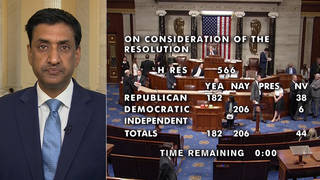
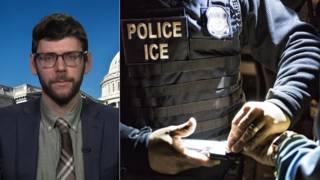
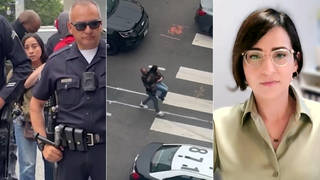
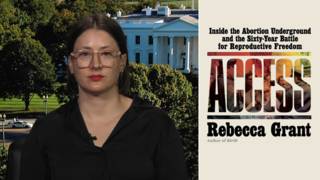
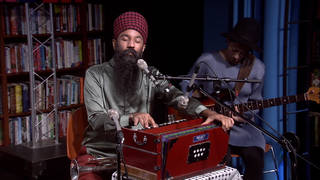
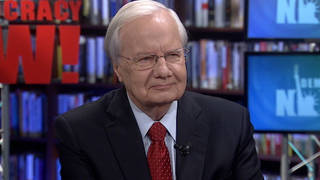
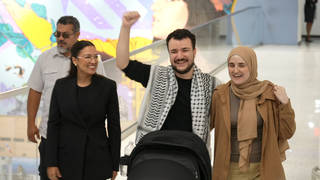

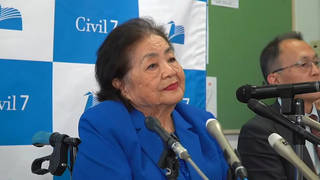

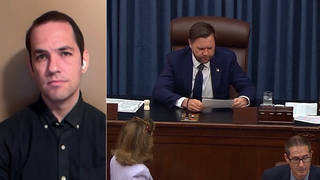
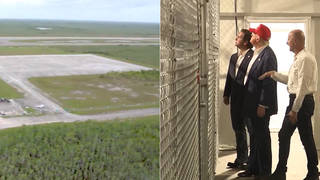
Media Options